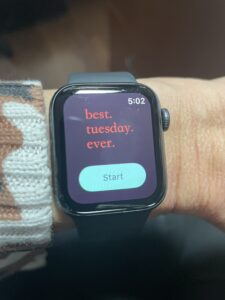 “Psych safety — is it really a thing?” a leader recently asked me.
“Psych safety — is it really a thing?” a leader recently asked me.
Yes, it is. We’ve got decades of research. Plus, you can now measure psych safety for yourself by wearing a smartwatch or other similar device that’s linked to a special app on your smart phone. Quantifying physiological changes in the moment provides much more useful neurologic data than the self-reported surveys that people have traditionally taken. Those surveys assess the degree of psychological safety someone thinks they’re experiencing at that one point in time, which isn’t as accurate as physiological data. And even more powerful, the app provides you with useful insights about your personal experiences.
Before delving into this game-changing technological innovation, let’s review what psychological safety is – especially for those who may not be all that familiar with the concept.
Reviewing three thought leaders’ views of psychological safety
The Harvard Business School Professor and author Amy Edmondson, who’s well known for her work in psychology safety, defines it “as the ability to speak up in a work environment without the fear of being humiliated or penalized.”
Author and consultant Tim Clark defines psychological safety as “feeling included, safe to learn, safe to contribute, and safe to challenge the status quo without fear of being embarrassed, marginalized, or punished.”
The neuroeconomist and author Paul Zak describes psychological safety as the “opposite of anxiety.” When you’re feeling psychologically safe, you have “available bandwidth in the brain” and can more easily absorb information. In other words, you have the cognitive and emotional bandwidth to pay attention, concentrate, and learn. By contrast, when you’re anxious, you’re using significant metabolic energy, which hurts your ability to focus and remember.
Dr. Zak’s initial research into psychological safety more than 20 years ago centered on students in the classroom. He identified a number of factors that hinder learning in addition to the negative social interactions that many of us associate with psychological safety. These other factors include hunger, lack of sleep, medical ailments, trauma of any kind, depression, and drug use.
He calculated the physiologic range in which individuals are psychologically safe and unsafe and tested his hypothesis by examining the impact on student performance. As reported in his 2022 book Immersion: The Science of the Extraordinary and the Source of Happiness, psychological safety had a strong positive association with students’ grades. In fact, a 25% increase in psychological safety increased students’ midterm performance by a full letter grade.
Adding immersion to psych safety
Over the years, Dr. Zak expanded his research on psych safety to study immersion with adults. Immersion measures what the brain values–what it pays attention to, what it resonates with emotionally, and what inspires actions. His research shows that people need social connections and want extraordinary experiences.
Immersion Neuroscience, which Dr. Zak founded, is the first company that measures immersion in experiences in real-time. His neurologic emotional fitness app, Tuesday: track, love, connect, measures psych safety and immersion in your heart rate through a wearable device, such as an Apple watch.
Why to measure immersion and psych safety with an app
The app is designed to provide you with custom objective insights in the moment to help you become more aware of your emotional state and wellbeing. And having used it for the last month, I can attest to its value. For example, I’m primarily using the app for some of my online meetings, workouts at the gym, and walks with the dog. (Full disclosure: Paul Zak is an active member of our npnHub of certified Neuroplasticians® and those interested in applied neuroscience.)
In my experiences to date, the app often alerts me that my brain is getting frustrated during meetings. The app has no clue why, so it asks me to consider what’s going on. Usually, I realize my attention has waned and I’ve started thinking about my next meeting. Or someone will say something that reminds me of a soul-sucking task I need to do.
In contrast, the app tells me my brain is feeling fabulous when I’m lifting weights at the gym or walking outside. Not surprisingly, my body and brain enjoy the physical movement, which balances the impact of the cognitive wear and tear on my brain during meetings.
So what? Isn’t this common sense? Yes, but common sense isn’t common practice for many of us. Seeing my individual numbers are a wake-up call for better managing my wellbeing throughout the day and week.
For those of you interested in science, the app is based on your brain’s direct and unique connection to your heart. The app measures your heart’s rhythms as your brain releases the neurotransmitters oxytocin and dopamine into your bloodstream. Oxytocin is strongly connected with social behaviors such as trustworthiness, generosity, and bonding with others. Dopamine plays a role in feeling pleasure, satisfaction, and a sense of accomplishment.
If I had been using the Tuesday app when discussing the existence psychological safety with the leader, who knows what would have frustrated my brain more? His doubting psych safety being a real thing or his complaining that one of his team members went to HR about the lack of psych safety rather than coming to him directly?
Let’s just say “Bless his heart!” – the Southern catch-all term that expresses extreme exasperation. This leader is missing the essence of psych safety. His team member wasn’t born the previous day. She realized she risked his wrath by going to him directly, especially since his preferred — and only? —leadership style is command and control.
While there are a number of ways to make meetings and other business settings psychologically safe, it helps if leaders are open to providing safety. Let’s cover how to provide psychological safety when I’ve got more available brain bandwidth….

0 Comments